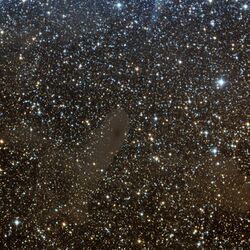Astronomy:Dark Doodad Nebula
| Dark nebula | |
|---|---|
 The Dark Doodad is the vertical streak at center | |
| Observation data: J2000 epoch | |
| Right ascension | 12h 25m 00s |
| Declination | −71° 42′ 00″ |
| Constellation | Musca |
| Physical characteristics | |
| Dimensions | ≈3 degrees |
| Designations | Sandqvist 149, CG 21, BHR 80, TGU H1875, DCld 301.7-07.2, [DB2002b] G301.70-7.16 |
The Dark Doodad Nebula is a dark nebula near the globular cluster NGC 4372, much closer than the centre of the galaxy and in the galactic plane, having a length of nearly three degrees of arc. Although officially unnamed, this long molecular cloud has come to be known under this name. It can be found in the southern constellation of Musca (the Fly) with strong binoculars.[1]
This cloud consists of regions of dense gas and dust, and is one of the closest star forming regions to the Solar System.[2] It was described in Sky & Telescope as one of the finest dark nebulae—one that is "wonderful, winding, and very definite".[3] Just to the east of the southern end of the Dark Doodad is NGC 4372.[3] It has also been called the Musca nebula and grouped as the Musca-Chamaeleonis Molecular Cloud.[4]
History
The nebula was catalogued by Aage Sandqvist, astronomer at Stockholm Observatory, in 1977.[5] The name Dark Doodad was given to it by American amateur astronomer and writer Dennis di Cicco in 1986 upon seeing an image he took from Alice Springs in central Australia.[1][6] Steven Coe gave it the name Sandqvist 149, because he believed it should be named after the astronomer who found it, though he acknowledges that the popular term prevails.[2]
Images

References
- ↑ 1.0 1.1 Nemiroff, R.; Bonnell, J., eds (December 8, 2008). "The Dark Doodad Nebula". Astronomy Picture of the Day. NASA. https://apod.nasa.gov/apod/ap081208.html.
- ↑ 2.0 2.1 Coe, Steven R. (2007). Nebulae and How to Observe Them. New York, New York: Springer. p. 95. ISBN 978-1-84628-482-3. https://books.google.com/books?id=roXyxpcc9MsC&pg=PA95.
- ↑ 3.0 3.1 Whitman, Alan (February 2002). "Nebulae of the Deep South". Sky & Telescope 103 (2): 108. Bibcode: 2002S&T...103b.108W. http://www.skyandtelescope.com/observing/objects/deepsky/3304821.html?showAll=y. Retrieved July 6, 2012.
- ↑ Hacar, A.; Kainulainen, J.; Tafalla, M.; Beuther, H.; Alves, J. (2016-02-24). "The Musca cloud: A 6 pc-long velocity-coherent, sonic filament". Astronomy & Astrophysics (EDP Sciences) 587: A97. doi:10.1051/0004-6361/201526015. ISSN 0004-6361.
- ↑ Sandqvist, Aa. (May 1977), "More southern dark dust clouds", Astronomy & Astrophysics 57: 467, Bibcode: 1977A&A....57..467S
- ↑ Ventrudo, Brian (May 27, 2008). "The 'Dark Doodad'". One-Minute Astronomer. Archived from the original on August 15, 2012. https://web.archive.org/web/20120815184059/http://www.oneminuteastronomer.com/OMALibrary/dark-doodad.html. Retrieved July 6, 2012.
External links
- "Sandqvist 149". SIMBAD. Centre de données astronomiques de Strasbourg. http://simbad.u-strasbg.fr/simbad/sim-basic?Ident=Sandqvist+149.
- Nemiroff, R.; Bonnell, J., eds (31 January 2013). "NGC 4372 and the Dark Doodad". Astronomy Picture of the Day. NASA. https://apod.nasa.gov/apod/ap130131.html.
Coordinates: ![]() 12h 25m 00s, −71° 42′ 00″
12h 25m 00s, −71° 42′ 00″
 |

